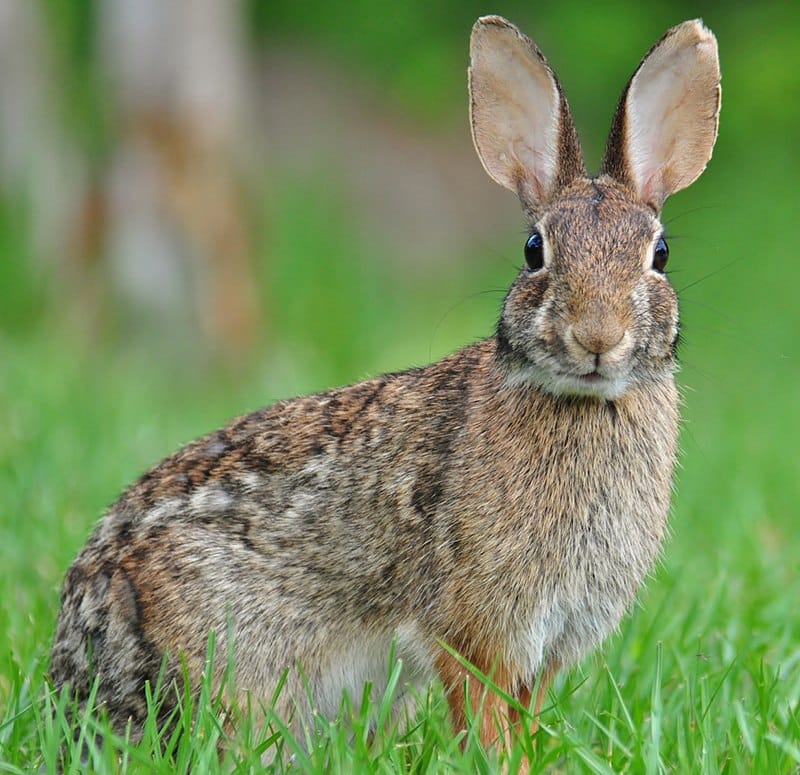Table of Contents
I have seen some extensive and unexpected rabbit damage over the past few weeks as I have been getting out into client’s gardens. As someone who recommends plants and helps people in the fight to protect their plants, this is becoming an even more varied and moving target. Every season brings new challenges.
With the long-term snow cover this Winter, unlike the last few years, rabbits were going after different plants. I have seen chew marks on stems of plants they don’t usually choose because of the limited options. With a couple feet of snow, at one point, rabbits were getting above some low protection that people installed. It allowed rabbits to get to the higher, smaller, and more tender branches of plants.

I have seen them top small leaf rhododendrons and azaleas, mow down spirea, deutzia, oakleaf hydrangeas, clethra and chokeberry to name a few. They chewed on the trunks of ornamental trees, including serviceberry, rose of Sharon, viburnums, lilacs and many more. Also, they did their pruning up of arborvitae, holly and others. When the populations explode and there is limited food in the winter, rabbits get desperate. They don’t hibernate. Here is a link to a comprehensive newsletter about rabbits that I wrote two years ago. It covers a lot of background information and strategies for managing rabbits.
Here we are in March and we need to start deploying the strategies outlined in the link before rabbits cause even more damage as plants start to emerge. This season I am asking clients to:
- Spray all newly planted material for at least the first month, even if rabbits never look at them. This will hopefully teach them and the young, inexperienced rabbits, not to browse. As you know, damage to young and smaller plants can set them back for the season.
- Consider spraying all established perennials for a month or two, as they come up, to give them a good start.
- All new shrubs with any stems at ground level smaller than a pencil in diameter need to be caged going into the fall, if not at planting. I am recommending the installation of larger plants that won’t get mowed down. This costs more but can get you past the period when rabbits go for small and tender stems.
The more we plant material that rabbits don’t like, the more desperate they get and expand the plants that they will tolerate. There is a theory that many people who grow food believe, which says to plant another untended garden for the rabbits and groundhogs. However, this can backfire by bringing more unwanted critters to your garden. This is more ammunition to get the rodenticide bans approved and make sure that any pest control services you use do not use poison in the management of rats, mice, etc. in your homes. When they get outside and die, the poison in their systems goes right up the food chain killing the necessary predators of rabbits, which are supposed to keep the population in check.
Let’s not forget that this isn’t nature. We have caused this problem by creating an imbalance by killing their predators and creating habitats for them to thrive.
Keep up the good fight!

Next, I am shocked and sympathizing with all of you over the challenges we are seeing from the cold weather this winter, on top of the drought. You may have noticed that some rhododendrons and azaleas have not fully come back from their winter form when the leaves curl up to protect from the cold. See the image below that shows a common sight I am seeing of plants with healthy looking leaves and curled leaves.
Check out this detailed article that discusses the science behind the curling of rhododendron leaves.
Basically, we are dealing with a significant issue of winter burn that is more extreme than we usually see in late winter. If you have plants with this damage, I recommend leaving them until they start to send out new growth later in the spring. By pruning out branches now, you will probably be pruning off more than you need to. I know it will look ugly, but just wait for new growth.
It can be hard to differentiate between winter burn, partially dead, and fully dead. With the drought last year, that is still lingering this Spring, I am seeing a lot of plants that died from drought and the Winter weather, as well as plants that just have Winter burn. Don’t rush and make rash decisions. We have had some good rain this Spring, just keep an eye on the weather and do all you can to revive your stressed plants. By late Spring, you should have your answer on the level of damage and from where new growth will sprout.
We’ll have to wait and see if there is any cold damage to our deciduous trees and shrubs. We didn’t have super cold weather this winter, but we did have some sustained periods of temperatures in the teens and lower. This froze the ground below the surface and made it hard for plants to get moisture during the warming spells. Most of February was well below freezing and then it suddenly started warming at the end of February and into March, but the ground remained frozen well into March. I was poking around during the second week and still found some hard soil but plants were exposed to sun and warming temperature and needed water. This is probably where the problems were compounded.
In the 25 years that I have been back working on the east coast, I have seen my USDA Plant Hardiness Zone go from a 5b to a 6b, which means, in theory, that we can grow plants that have a lower tolerance to cold. However, what we are seeing with these shifts in climate is that the average temperatures may be rising, but the variation and extremes seem to be expanding too. Nurseries are always pushing the line with plants they offer, so make sure as you add plants to your garden, you understand the temperature ranges in which they survive. If you are going to purchase plants that are right on your hardiness limit, know that you may need a bit of luck and protection to get them established.
Reed Pugh works to help people get the most from their gardens as a horticulturist, educator, designer and gardener, with his company Barking Dog Gardens.









